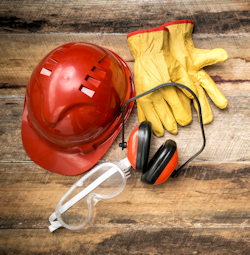Personal Protective Equipment
Personal Protective Equipment must be worn and used in a manner that will make full use of its protective qualities.

Personal protective equipment used incorrectly potentially exposes an employee to hazards, which defeats the reason for using PPE. To review a "PPE for Workers Checklist" click here.
Eye and face protection should be used based on anticipated hazards. Safety glasses or goggles should be worn any time work operations present an eye hazard. For example, safety glasses or goggles should be worn during welding, cutting, grinding, nailing (or when working with concrete and/or harmful chemicals or when exposed to flying particles).
Head protection (i.e., hard hats) should be used where there is a potential for objects falling from above, and bumps to the head from fixed objects. Hard hats should be routinely inspected for dents, cracks or deterioration. Replace your hard hat after a heavy blow and ensure it is maintained and in good condition.
When worn alone, face shields do not protect employees from impact hazards. Workers should use face shields in combination with safety spectacles or goggles, even in the absence of dust or potential splashes, for additional protection beyond that offered by spectacles or goggles alone.
Safety Basics: Personal Protective Equipment - CAT
Your employer must do the following:
- Pay for PPE as required by OSHA.
- Provide and require the use of appropriate PPE in all operations where there is an exposure to hazardous conditions.
- Ensure the adequacy of PPE including proper maintenance and sanitation.
- Provide head protection (e.g., hard hats, helmets) whenever there is possible danger of head injuries from impact, flying or falling objects.
- Provide eye and face protection when machines or operations present eye or face injury.
- Provide workers involved in welding operations with filter lenses or plates of proper shade number.
- Ensure eye, face, and head protective equipment meets ANSI requirements.
Knowledge Check Choose the best answer for the question.
6-8. When worn alone, using face shields _____ employees from impact hazards.
You forgot to answer the question!
